BY LINCOLN ANDERSON | Updated Feb. 10, 12:45 p.m.: One of local residents’ biggest issues with the Open Restaurants program — the much-maligned roadway sheds — will be scrapped by 2023. At least that’s what the city is now saying.
In between a lot of governmental verbiage and scores of people testifying for and against the outdoor dining program becoming permanent, that piece of news was one of the takeaways from Tuesday’s marathon, nine-hour City Council hearing.
Julie Schipper, the director of the Department of Transportation’s outdoor dining program, made the announcement that the city is “not envisioning” keeping the sheds in the permanent program, which would start next year. She said the structures would be replaced by curb-lane dining areas that would instead be protected by barriers and sport umbrellas or tents. These outdoor dining spots would mainly be used seasonally, in warm weather, basically when there is customer demand for them, she said.
Currently, more than 12,000 operators citywide participate in Open Restaurants. All of these businesses would need to reapply to have outdoor dining under the permanent program, and none of the current structures would be grandfathered, Schipper explained.

But that doesn’t mean fired-up Downtowners attending the virtual event were pacified. They repeatedly argued that the Department of Transportation’s “one size fits all” Open Restaurants plan does not fit their neighborhoods. They were backed up by new City Councilmembers Erik Bottcher and Christopher Marte, both of whom argued that the narrow streets in nightlife-dense Downtown and Lower Manhattan can’t handle the droves of dining sheds currently flooding the area. The two councilmembers’ districts contain more than 20 percent of the entire city’s dining sheds.
‘One size fits all’ not a good fit
“We have to come up with a plan that works well for all communities,” Bottcher, who represents Greenwich Village, Chelsea and Hell’s Kitchen, stressed in his testimony.
Bottcher noted that a sheds survey in Council District 3 done under his ex-boss, former Council Speaker Corey Johnson, found that 93 percent of them were out of compliance. Based on those results, Bottcher asked, how can his constituents “have confidence D.O.T. will enforce [the shed regulations] in the future, when they haven’t done anything up till now?”
Similarly, arguing against the proliferation of the dining-and-drinking shacks in his own Council District 1, Marte added that Lower Manhattan “has some of the smallest streets and most dangerous streetscapes in the city.”
Adding to the sense that Open Restaurants is a seat-of-the-pants, disorganized program, Bottcher disapprovingly noted that a FAQ’s (frequently asked questions) link on the D.O.T. Web site regarding Open Restaurants redirected to a “Page Not Found.”
Meanwhile, Councilmember Carlina, whose District 2 includes the East Village and Lower East and who is a big supporter of both Open Streets and Open Restaurants, was a no-show at the hearing.
‘Dark canyons’ not grand
However, Susan Stetzer, the district manager of Community Board 3, which includes the East Village, Lower East Side and Chinatown, said the rows upon rows of dining sheds “block the light and create dark canyons.” She said that, due to outdoor dining, street noise complaints had risen 169 percent compared to pre-COVID numbers. C.B. 3, she noted, also has the city’s second-highest number of grandfathered side-street commercial bars and restaurants — 134 — which now are being allowed to have outdoor dining, though previously could not.
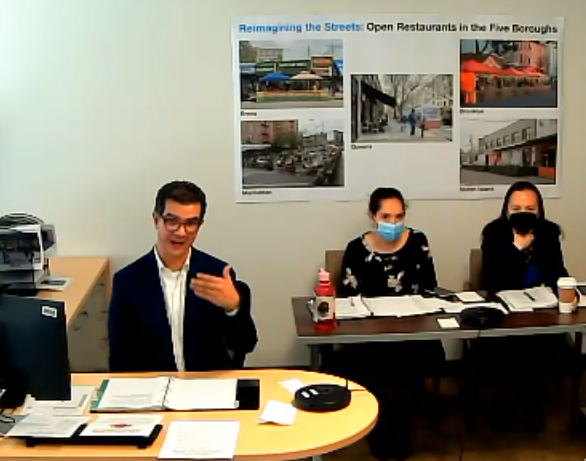
Meanwhile, Community Board 2, covering Greenwich Village, Soho and Little Italy, has more than 1,000 Open Restaurants, the most of any of the city’s 59 community boards. Jeannine Kiely, C.B. 2 chairperson, said outdoor dining exclusively helps one industry. Plus, she said, locals would like to have other options in the curbside lane.
“Why not a basketball hoop or a parklet?” she offered.
Meanwhile, a lawsuit against Open Restaurants filed in October by nearly two dozen residents, including many from Downtown Manhattan, is still alive after the city recently failed to get it summarily tossed out of court. The suit argues that the citywide program never underwent a proper environmental impact study.
Club owner: ‘COVID’s not over’
During the Council hearing, bar and restaurant operators, for their part, repeatedly praised Open Restaurants as a “lifeline,” stressing that the outdoor seating is very much still needed. Some customers, they noted, still aren’t comfortable sitting indoors amid the ongoing pandemic or aren’t even vaccinated — many children are not — so can only sit outdoors. And whenever a new variant, like Delta or Omicron pops up, some operators said, the number of restaurant-goers dips again, so the extra outdoor seating is needed to make up for it when diners return.
Paul Italia, a partner in The Stand stand-up comedy club in Union Square and Joey Roses Sandwich Shoppe on the Lower East Side, said keeping outdoor dining is crucial for his businesses.
“We’re all in this together,” he testified. “COVID’s not over. If not for the outside [seating], we would have had to shut down again 30 or 40 days ago.”
(Italia doesn’t appear to be hurting financially, though. Along with “Saturday Night Live”’s Pete Davidson and Colin Jost, he recently purchased a retired Staten Island Ferry boat for $280,000 with plans to turn it into a floating bar and restaurant.)
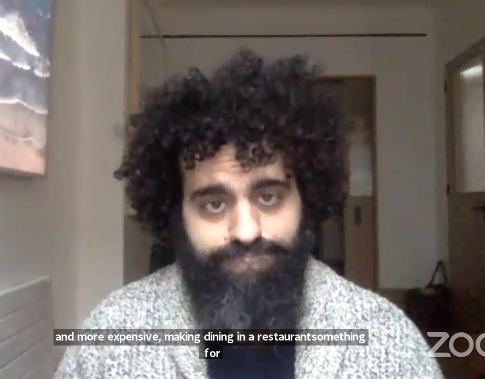
Gabriel Stolman, who owns a West Village restaurant group — including Joseph Leonard, Jeffrey’s Grocery, Fairfax and Jolene — said outdoor dining at least allowed him to save half of his business during the pandemic. He said that before COVID, he had nine restaurants and 350 employees, but now has only four restaurants and 150 employees.
“Without outdoor dining, I would have lost all of my business,” he said, assuring, “As an owner, I don’t want rats and litter or bad-looking sheds.”
Advocating for eliminating sidewalk cafe restrictions, Stolman claimed he was once denied a sidewalk cafe permit because a sidewalk was “2 inches too narrow.”
Claims new barriers will be rat-proof
Meghan Joye, a former C.B. 3 member who owns five Manhattan bars, admitted, “Rats, noise at night are huge problems,” though assuring, “but together we can deal with it.” She said rats live in the sandbags protecting the sheds, but that these will be replaced by rat-proof steel structures under the permanent plan.
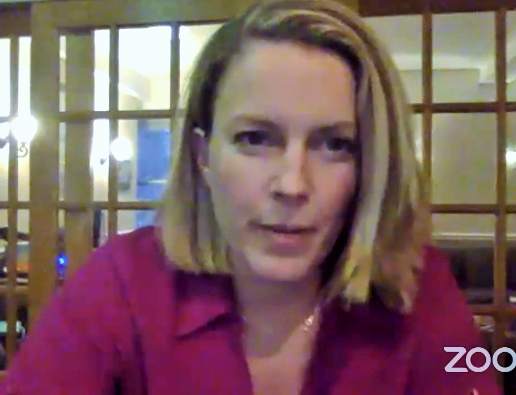
“We can close earlier, especially on the side streets that are residential,” she offered.
However, in a rendering of a seasonal roadway dining space that D.O.T. posted on Twitter, the barriers are shown as planters and described as being “completely filled with soil or sand.”
Gotta love how @NYC_DOT says the new version of outdoor dining will be seasonal and removed when not in use, but includes a SNOW STICK in their plan! #chuckthesheds @ChrisMarteNYC @ebottcher @CarlinaRivera pic.twitter.com/z1AAossoKp
— Stuart (@Stuart39906233) February 9, 2022
Andrew Rigie, the executive director of the New York Hospital Alliance, said Open Restaurants is “about equity” and urged that the program be continued.
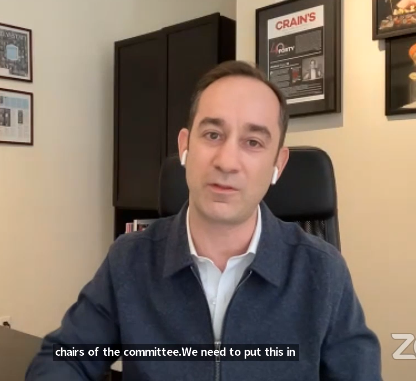
“We shouldn’t be so much focused on what didn’t work but what’s going to work in the future,” he stressed.
Planning by diktat vs. democracy
Although it was billed as a hearing with public input, councilmembers who led Tuesday’s discussion imperiously made it clear upfront that it was a foregone conclusion that the Open Restaurants program would become permanent. That’s been par for the course for Open Restaurants since former Mayor de Blasio back in September 2020 unilaterally declared the in-street dining scheme was here to stay.

Bronx Councilmember Marjorie Velazquez, one of the meeting’s co-chairpersons, noted approvingly that her home borough, thanks to outdoor dining, went from having just 30 sidewalk cafes to 650 outdoor eating spots, and that the new program has “real equity consequences.”
In addition to Open Restaurant spaces, because sidewalk cafe regulations have been suspended during the pandemic, it has allowed 3,500 restaurants citywide to now sport sidewalk cafes that would previously have been barred from having them. Basically, the suspension of zoning means sidewalk cafes can be sited almost anywhere — including even in quiet residential areas previously off-limits in consideration of locals’ right to quality of life. Soho, for example, previously was a neighborhood where sidewalk cafes were not allowed.
Velazquez is the prime sponsor of the bill that would both remove sidewalk cafe regulations and make Open Restaurants permanent.
Velazquez and other advocates repeatedly said Open Restaurants has saved 100,000 jobs — though, during the hearing, opponents increasingly challenged this assertion, alleging it seemed a conveniently made-up sound bite.
At the same time, Velazquez acknowledged outdoor dining has caused complaints of “excessive noise, an increase in trash and vermin [and] a handful of accidents” where cars have crashed into the sheds. She also admitted that abandoned sheds are “an eyesore.” Nevertheless, she stressed, the Open Restaurants program “must continue.”
D.O.T. to keep running Open Restaurants
Ydanis Rodriguez, the D.O.T. chairperson, said that 50,000 inspections of the sheds had been done — at one point saying these inspections had all been “in the past couple of months.”
“We will have an even greater focus on inspections and compliance,” he assured, though admitting, “We have a few bad apple.”
The top fine for Open Restaurants violations is $1,000, according to D.O.T.
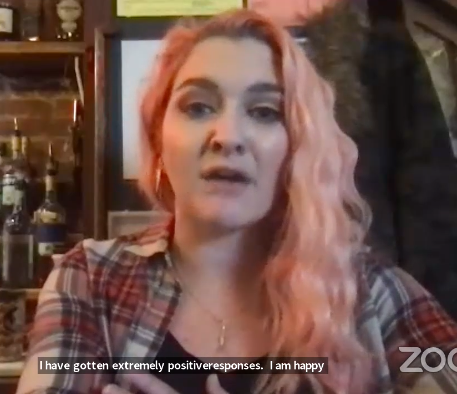
Steven Ettannani, a spokesperson for the Department of Consumer and Worker Protection (the agency that formerly oversaw sidewalk cafes), declared, “D.O.T. is the appropriate agency to continue this program because it’s been a resounding success.” Although members of the public, when not testifying, were muted on Zoom, one could imagine the derisive laughter and angrily clenched computer mice at that statement. Indeed, throughout the meeting, residents, as well as some councilmembers, accused D.O.T. of not being up to the job.
Velazquez at one point scolded Rodriguez and his team for not having statistics at their fingertips for the number of fines issued over the sheds, how many warnings have been given and how many have been shut down by D.O.T.
“You should have these data points,” she chided, asking him how he could claim the permanent program would be more “efficient” without this information.
After locating the figures, D.O.T. shared that 22 fines have been issued over the sheds, that the agency has removed 40 of the structures, that there have been around 4,300 warnings and 99 cease-and-desist orders.
Rodriguez said D.O.T. is “in the process” of hiring 30 inspectors to oversee enforcement and compliance for Open Restaurants. However, voicing the thoughts of many, one resident later skeptically questioned how 30 personnel could possibly hope to inspect 12,000 roadway sheds scattered all over the city.
Usually, Rodriguez deferred to Schipper on details of the program. At one point, though, seeming to contradict her, Rodriguez appeared to say that sheds that are well-built might be allowed to stay.
Councilmembers’ concerns
A number of councilmembers themselves also raised concerns about the sheds. Chi Oseé said he has gotten numerous complaints about “sanitation and abandoned structures” in his district. Sandy Nurse said the shed’s platforms create “a haven for rats” that live beneath them. Amanda Farias noted that, in fact, 64 percent of the city’s community boards voted not to approve making the Open Restaurants permanent. Lincoln Restler, though a supporter of outdoor dining, questioned if D.O.T. “is the right agency to maintain the program going forward,” citing issues like sanitation and enforcement.
“This is adding a whole new, separate function to an agency that really didn’t have this experience,” the councilmember said.
“Who will be enforcing what?” Councilmember Gale Brewer asked, adding of peeved residents, “They’re gonna call N.Y.P.D. [with their complaints] … There’s a need for cross-training [of agency officials],” she said.
But D.O.T. Commissioner Rodriguez countered, for one, that rats are “a decade-old problem.” He added that restaurateurs would sign a commitment to control rats and would be “partners” in keeping their outdoor areas clean.

Councilmember Kalman Yeger blasted the presence of “ghost sheds” — abandoned dining huts — throughout his district. He said Open Restaurants gifted operators with expanded footprints, without having to pay any additional rent.
“It’s been a success for the restaurateurs,” he said of the program. “But it hasn’t been a success for people who use the sidewalks and the streets of New York City.
‘We’re past the emergency’
“We’re past the [pandemic] emergency,” Yeger said. “Restaurants are [fully] open. While we’ve created a program for restaurants, we haven’t created one for the shoe store or hardware shop next door, which have lost space.”
He said the dining sheds hurt local neighboring merchants by making blocks “sloppy, chaotic and anarchic.”
Doubting D.O.T.’s ability to oversee the massive new program, Yeger asked Josephine Beckman, the district manager of Brooklyn’s Community Board 10, how long it takes the agency to install a speed bump on a street.
“Two to three years,” she answered.
In fact, at the Council hearing, about three hours was devoted to councilmembers’ questions and concerns posed to D.O.T. officials about the program. This fact led some residents, testifying later on during the hearing, to charge that approval of the permanent program clearly is being rushed through, to the point that even councilmembers themselves clearly are both confused and concerned about exactly what is being proposed. The program must go through a full and proper public review, residents stressed.
Residents’ angry rants
In their testimony, residents vented anger and frustration over the intrusive program that they charge has turned their lives upside down and frayed their psyches.

Williamsburg resident Shannon Phipps, while cradling her baby, complained the noisy sheds have wrecked her ability to sleep and have bred problems on the streets.
“We are inundated with these sites,” she railed. “We had a lepto [lethal dog disease] outbreak due to rats and standing water…people shooting up [in the sheds]. The noise cannot be mitigated. This is clearly an aggressive act by the D.O.T. and city government to take over our public space. Who are you to tell me that I can’t sleep at night?” she accusingly asked the government officials.
Skeptical that the program had really saved 100,000 jobs, she demanded to see the figures.
“It’s a fake number,” she declared. “It’s a nice, round number and it’s fake.”

Susi Schropp, who lives on St. Mark’s Place between Second and Third Avenues, slammed Open Restaurants as “terrible planning” and “not visionary thinking.” Her block is lined with wall-to-wall sheds, she said, adding that in front of one restaurant, V Spot, the pedestrian path has been narrowed to just 3 feet wide.
Leslie Clark, a leader of the West Village Residents Association, said, like others, she supported Open Restaurants at first, wanting to help businesses survive the health crisis.
However, she said, “I never realized that the 108 diners who were outside my window would be there forever.”
Blocking bike lanes
Michael Marino, a C.B. 3 member, complained that, as a cyclist, he risks being “clotheslined” by electrical wires strung across the bike paths to the sheds, which themselves dangerously block bikers’ sightlines. He said that on Clinton Street, due to the sheds that fill one side of the street, parked cars block the bike lane on the other side — with one restaurateur even using a dummy dining shed to hold a parking space for his car.
However, in his testimony, Marco Conner DiAquoi, a staffer at Transportation Alternatives, said the cycling-advocacy group supports Open Restaurants as a higher use than “storage of cars” a.k.a. parking.

Greenwich Village writer Stuart Waldman fumed that D.O.T. had claimed Open Restaurants would have “no negative impacts.” He held up a small tape recorder and played a snippet of the outdoor-dining din from his street that he had taped from inside his apartment.
“You can have 100 people out on a street till midnight or 1 a.m. and it’s called a residential street?” he said in disbelief. “It’s impossible to mitigate noise from these sheds. … Start over. Get an E.I.S. [environmental impact statement].”
Former Council candidate Allie Ryan called Open Restaurants “a decaying failure. In my neighborhood, the East Village, I and my two young children are surrounded by abandoned, graffiti-covered sheds,” she complained.
Kyle Sklerov, a young Greenwich Village resident, spoke about the relentless impact of having a dining shed right outside his small apartment.
“This program,” he said, “is just a neighborhood destroyer.”
Dale Goodson said Avenue A between 12th and 14th Streets now has four noisy outdoor seating areas that weren’t there pre-COVID.
“My quality of life has been hijacked and sacrificed and I feel trapped,” he said. “I can’t afford to move.”
Toward the end of the daylong hearing, Janet Hershberger offered a new idea on how to address the issue. She said outdoor dining simply is too big, with too great an impact on city residents, to be decided by diktat by the City Council and mayor.
“I think this should be a ballot referendum,” she said. “Let the people of New York speak. Put it on the ballot in November.”


As to DOT enforcement: There was a shed surrounding a fire hydrant on my block that took more than a year to be removed …only the shed. Now the barriers, tables, chairs, etc. are still there blocking the fire hydrant…just no roof. So this is what to expect from DOT as far as enforcing rules.
Issue: Narrow streets with dining sheds across from bike lanes leave no room for cyclists.
Cars need to drive through the bike lane because there just isn’t enough space otherwise.
Example: 4th St. between 1st and 2nd Ave.
Establishments that have frontage for a Sidewalk Cafe should NOT ALSO have a Street Shed. Choose one or the other. Additionally, corner establishments that already have Sidewalk Tables should not be permitted to also have a Shed on their Avenue PLUS Street Sheds on their side streets. To cite just two examples in Chelsea, one restaurant has a Sidewalk Cafe seating 42, an avenue shed seating eight, plus two sidestreet sheds seating sixteen each, for a total of 82 additional outdoor seats. The second; 42 Sidewalk Seats, 34 Avenue Seats plus 46 Seats on its side street. That’s a total of 122 additional Outdoor Dining Seats, not to mention now being at 100% indoor capacity! Surely this overuse & abuse of public space for one business sector to expand its capacity by doubling/tripling it, was not the intention of the original Emergency Dining plan during the shutdown.
Other Sidewalk Cafes that have been installed by restaurants have more or less built permanent structures attached to their storefronts that often extend beyond the 8-foot sidewalk clearance originally required. Business owners knew of this regulation from the beginning and many simply chose to ignore it. Complaints to DOT, including photos, come back as “no situation observed.” When I inquired about this, I was told Dept. of Buildings handles everything from a building’s Front to the Curb, while DOT handles everything from the Curb into the Street. Going forward, it needs to be made abundantly clear just which city agency will be responsible for the Open Restaurants program, including both Sidewalk Cafes & Street Dining Sheds.
Thank you Chris Marte, Erik Bottcher (finally, city councilmembers that care more about their constituents than money from special interest groups) and Susan Stetzer for listening to the “vox populi”!
Shame on Marjorie Velazquez for “making it clear” that the Open Restaurants program was already a done deal, not to mention Carlina Rivera, who didn’t even show up to discuss an issue that is at its worst in her district.
“…but together we can deal with it.”
Yes, Meghan is right, together we could deal with issues. The problem is that the community/community board is not allowed at the table and we are not allowed to deal with this together. The City has caused this backlash by not enforcing guidelines and ignoring complaints and problems.
So true, Susan!
If the DOT had removed dining structures that were too close to the sidewalk
If the DOT had removed dining structures that were in “No Standing” zones
If the DOT had removed dining structures that were wider than 8 feet
If the DOT had removed dining structures that were built on top of utility-access manholes
If the DOT had removed abandoned dining structures after 30 days
If NYPD has been allowed to remove powered loudspeakers from the dining sheds (amplified music was expressly prohibited, after all)
We would not see this backlash.
The Village Sun missed one testimony by Zach Neil, owner of Beetle House in East 6th Street, who, according to a comment on EV Grieve, has opened a plethora of “shitty tawdry theme restaurants in” [the East Village ].
I want to take this opportunity and introduce Zach, pal, to a few “old white women” (his words) who think they own the land. Mr. Neil a known entity to East Village nightlife and hospitality through gimmicky attempts like’ Merica, Steamy Hollows, and Beetle House (what’s next, CBGB inspired lounge?).
Zach, if you see this, I want to introduce you to three fantastic (old, white—your words) women in zoning: Jane Jacobs, Frances Goldin, and Doris Diether.
Without them, there would not be the neighborhood you claim as your own through your ancestry. An old white man, Robert Moses, would have turned it into a highway along the lines of the Cross-Bronx Expressway.
Cheers, bro!
Thanks for pointing that out, Dalcini, but technically we did not miss it. We just decided that the article was already pretty long and, well, Neil’s comment was ultimately not constructive and was not only obnoxious but sexist, ageist and actually racist, too. Here is what we originally had in the article but then chose to cut out in the final edit. We were thinking of doing a “Scooby Scoop” item with it, though. …
“Taking it further, Zach Neil, the owner of Beetle House NYC, a Tim Burton-themed bar and restaurant in the East Village, nastily lashed out at Open Restaurants opponents.
“Saying he was part Native American and that Manhattan is stolen land, Neil said, ‘I find it kind of offensive…a bunch of elderly white women complaining about losing public land.’
“Later on, a resident who said she is part Native spoke against the Open Restaurants program.”
It’s worth noting that no one from the city called out Mr. Neil on his abusive comment.
Yes, we had the same thought. That would have been the time for an “adult in the room” from the City Council to say something about keeping the discussion civil. Community Board 3, for example, says this during Zoom meetings.
Oh please, come on. You have covered meetings that have gotten much more hostile than this with people, primarily on your side, being much more rude and even physically aggressive. This was, at most, a purposefully abrasive comment, and really only in the opening, after which he acknowledged and agreed with some of the issues people have. This pearl-clutching routine is embarrassing.
Zach Neil’s performance at the NY City Council: https://www.youtube.com/watch?v=lJIclzSCCmE
A big ugh.
Maybe Zack Neil’s mother should be interviewed about his view of “old” people….
Ha! Great idea.
Bronx Councilmember Marjorie Velazquez, one of the meeting’s co-chairpersons, noted approvingly…that the new program has “real equity consequences.” Love how the only consequences she is concerned about are based on equity, and not about the quality of life of the people she was chosen to represent. The City Council is a joke, the vast majority of them are for-hire-to-the-highest-bidder shills, in this case the restaurant and nightlife industries, and their constituents be damned.
Interesting to note the non-presence at this meeting of Carlina Rivera, councilwoman with both the second-highest number of sheds and a bunch of residents violently opposing them; wonder whose well-lined pocket she was snugly ensconcing herself in rather than showing up and doing the work for which we pay her?
BTW there is an article in Crain’s (unfortunately a paywall) discussing that NYC restaurants have been doing very well on weekends – NYC residents are back.
The article noted that the weekdays are the weak spot and that this business was largely dependent on workers returning to the office and tourists.
(Anecdotally, have definitely noticed full restaurants – inside. Not in outside street shacks)
Is the Hospitality Alliance lobbying to get the powers that be to force workers back to the office to ensure restaurant business?
The street shacks need to go.
And the City needs to help small retail/non-food businesses that are suffering due to Covid and impacted by ecommerce and chain proliferation like Target
I second Janet Hershberger‘s suggestion, create a ballot referendum. Let residents NOT politicians (influenced by lobbyists) decide.
Good idea. Let’s do it.
Restaurants are no different than other businesses dealing with and trying to survive covid at this point. The sheds are dirty, obstructive and its just plain unfair for restaurants to have twice the space for free, paid for by the inconvenience of residents who pay high taxes and high rents dealing with the noise and garbage.
This is a plan that helps a few at the expense of many. It’s gone on for two years and now is the time for it to end. Let’s lower the noise and reduce problems in NYC. Residents and businesses must live together not at odds and it’s up to the elected officials to learn and navigate fairly.
I agree. The public sidewalks should be for public programs. This zoning proposal gives landlords more free land.
Restaurants will have a rude awakening when the rents go up accordingly, and they will.
Right now, they have a chance to make up for the loss, but that honeymoon will be over fast when landlords include the extra space in their leases, which they can only do if the temporary measure becomes permanent.
Restaurants would be much better off advocating for an extended temporary rule (e.g., 3-5 years), and most of the community would be behind them in support.